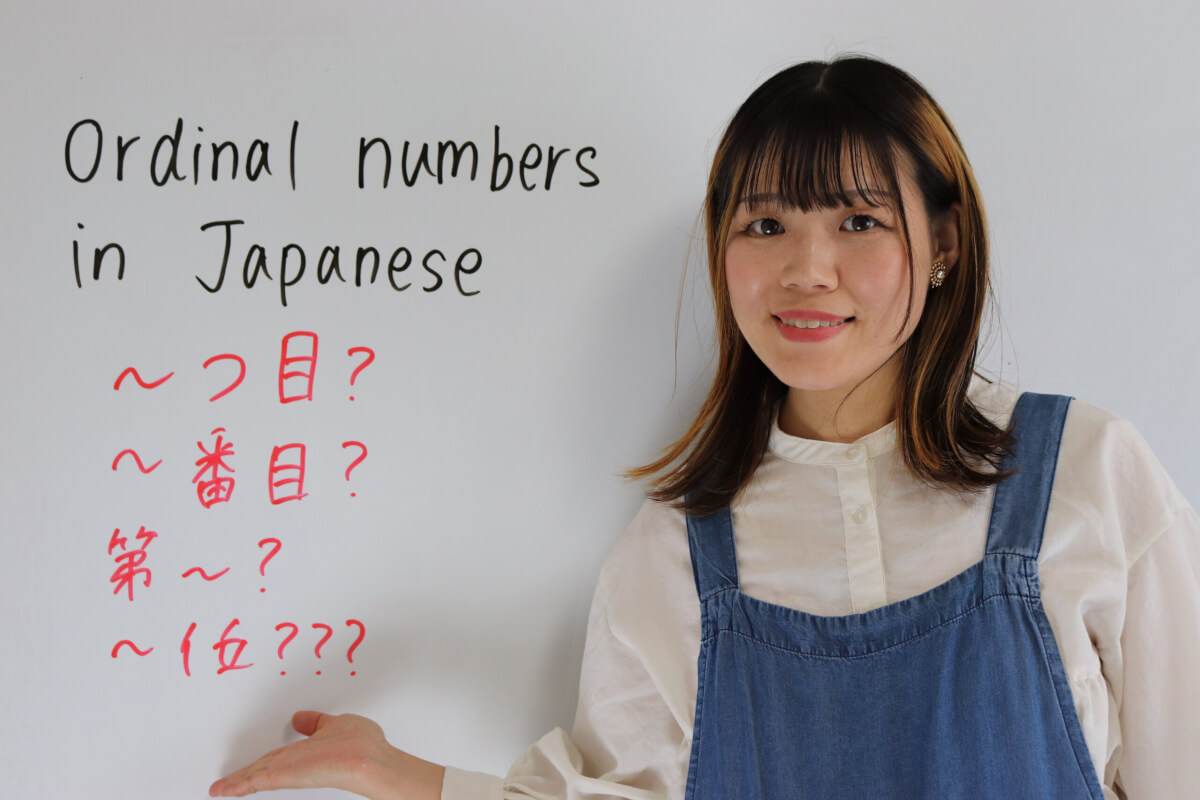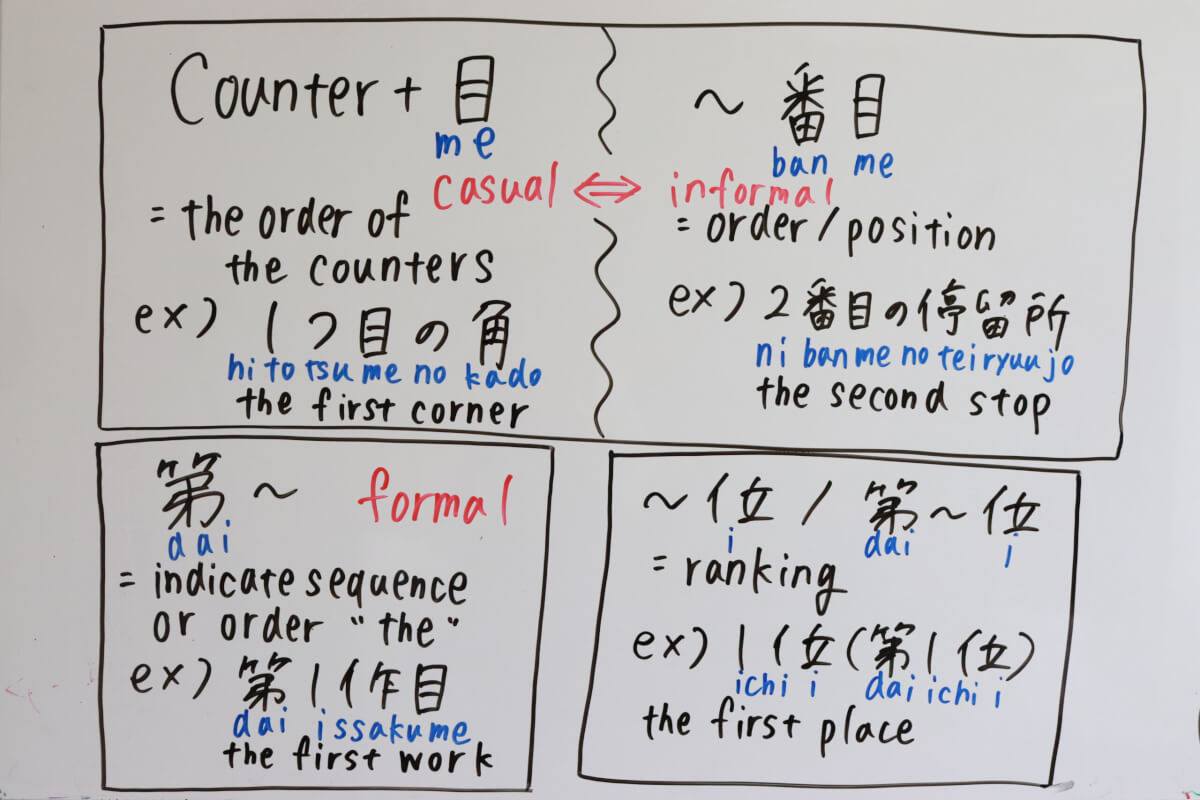- Release Date:
Ordinal numbers in Japanese

Once you can say Japanese numbers, let's study ordinal numbers next. In Japanese, ordinal number is called "序数 /jo suu/". Unlike in English, there are several ways to say it, so let's learn how to say each one and their differences.
How to say ordinal numbers in Japanese?
The three main ways of saying ordinal numbers in Japanese are "Counter + 目/me/", "~番目/ban me/", and "第~/dai~/", and "~位/~i/". The most commonly used is "Counter + 目/me/". Let's learn this first.
Counter + 目(me)
There are many counters in Japanese, and by adding "目/me/" to the counter, you can indicate the order of the counters.
This "目/me/" means also "eyes" in Japanese, but in this case, it means order. This "eye" is often written in Hiragana "め/me/" instead of Kanji.
Examples
Let's look at an example using the most commonly used Japanese word counter, "つ. Of course, you can attach it to other counters as well.
This "つ" is the most specific and concise way to express a small or general count, such as "一つ目の角 /hitotsu me no kado/ the first corner" or "三つ目の建物 /mittsume no tatemono/ the third building.
| Kanji | Hiragana | Romaji |
|---|---|---|
| 一つ目/1つ目 | ひとつめ | hitotsu me |
| 二つ目/2つ目 | ふたつめ | futatsu me |
| 三つ目/3つ目 | みっつめ | mittsu me |
| 四つ目/4つ目 | よっつめ | yottsu me |
| 五つ目/5つ目 | いつつめ | itsutsu me |
| 六つ目/6つ目 | むっつめ | muttsu me |
| 七つ目/7つ目 | ななつめ | nanatsu me |
| 八つ目/8つ目 | やっつめ | yattsu me |
| 九つ目/9つ目 | ここのつめ | kokonotsu me |
Numbers can be either Kanji or Arabic numbers.
- 日本で三つ目の本を買いました。
/nihon de mittsu me no hon o kaimashita/
I bought the third book in Japan.
- 二つめの問題は難しいが、一つめは簡単だった。
/futatsu me no mondai wa muzukashii ga, hitotsu me wa kantan datta/
The second quiz was difficult, but the first one was easy.
- 日本でできた1人目の友達は、同い年の子でした。
/nihon de dekita hitorime no tomodachi wa onaidoshi no ko deshita/
The first friend I made in Japan was the same age as me.
~番目(ban me)
The previous "~つ目/~ tsu me/" and "~番目/ban me/" are very similar. What's the difference?
"~番目/ban me/" is used to indicate order or position, and is often used in relatively formal documents and official situations. "番/ban/" is a common counter for number.
On the other hand, "~つ目/~ tsu me/" is often used in colloquial, everyday speech. It is a little more casual and easy to use. For example, one can count "一つ目/hitotsu me/," "二つ目/futstu me/," or "三つ目/mittsu me/," but these are more casual expressions.
Also, "~つ目/~ tsu me/" is generally shorter than "~番目/ban me/".
Thus, "〜番目" is used in more formal documents and situations, whereas "~つ目/~ tsu me/" is often used in everyday conversation and casual documents.
Examples
| Kanji | Hiragana | Romaji |
|---|---|---|
| 一番目/1番目 | いちばんめ | ichi ban me |
| 二番目/2番目 | にばんめ | ni ban me |
| 三番目/3番目 | さんばんめ | san ban me |
| 四番目/4番目 | よんばんめ | yon ban me |
| 五番目/5番目 | ごばんめ | go ban me |
| 六番目/6番目 | ろくばんめ | roku ban me |
| 七番目/7番目 | ななばんめ | nana ban me |
| 八番目/8番目 | はちばんめ | hachi ban me |
| 九番目/9番目 | きゅうばんめ | kyuu ban me |
| 十番目/10番目 | じゅうばんめ | juu ban me |
Numbers can be either Kanji or Arabic numbers.
- 私の部屋は2番目の階にあります。
/watashi no heya wa nibanme no kai ni arimasu/
My room is on the second floor.
You can also say casually but with the same meaning:
私の部屋は2つ目の階にあります。
/watashi no heya wa futsu me no kai ni arimasu/
- この列車は3番目の停留所で止まります。
/kono ressha wa san ban me no teiryuujo de tomarimasu/
This train stops at the third station.
You can also say casually but with the same meaning:
この列車は3つ目の停留所で止まります。
/kono ressha wa mittsu me no teiryuujo de tomarimasu/
- 二番目の子供は、男の子です。
/niban me no kodomo wa, otokonoko desu/
The second child is a boy.
You can also say casually but with the same meaning:
2人目の子供は、男の子です。
/futari me no kodomo wa, otokonoko desu/
In this case, "2人/futari/" is better than "2つ/futsu/" because of the way we count people.
第(dai)~
This "第~/dai~/" and "~番目/~ ban me/" are also similar. "~番目/~ ban me/" corresponds to "the ~th", while "第~" corresponds to "the ~".
"第~/dai~/" is a more formal expression used to indicate sequence or order, often seen in formal documents or situations. It is commonly used to specify the position of something within a series, such as books, chapters, episodes, matches, tournaments, and the like.
In simpler terms, "~番目/~ ban me/" is a more general and common expression used in everyday situations, while "第~/dai~/" is commonly used in more formal contexts.
Examples
| Kanji | Hiragana | Romaji |
|---|---|---|
| 第一 | だいいち | dai ichi |
| 第二 | だいに | dai ni |
| 第三 | だいさん | dai san |
| 第四 | だいよん | dai yon |
| 第五 | だいご | dai go |
| 第六 | だいろく | dai roku |
| 第七 | だいなな | dai nana |
| 第八 | だいはち | dai hachi |
| 第九 | だいきゅう | dai kyuu |
| 第十 | だいじゅう | dai juu |
When "第~/dai~/" is used, Kanji numbers are better. However, Arabic numbers are sometimes used casually.
- その映画は彼の第五作目で、今までで最も人気があります。
/sono eiga wa kare no dai gosakume, imamade de mottomo ninki ga arimasu/
That film is his fifth and most popular to date.
- 私たちは会議の第二部で議論を始めました。
/watashi tachi wa kaigi no dai nibu de giron o hajimemashita/
We started the discussion in the second part of the meeting.
- 第一章は物語の序盤を紹介します。
/dai isshou wa monogatari no joban o shoukai shimasu/
The first chapter introduces the beginning of the story.
~位(i)/第~位(dai ~ i)
The term "~位/~i/" is used to indicate the rank or ranking of something. For example, it is often used to indicate the results of a competition or a person's ability.
~位(i) or 第~位(dai ~ i)?
When indicating rankings or positions, "~位/~i/" is used. It is used not only to indicate specific numerical values or sequences but also commonly in everyday expressions, sports results, rankings, etc.
On the other hand, '第~位' is more formal and is commonly used when explicitly stating the sequence in documents or texts. It is especially used to indicate the order of series or consecutive items such as books, chapters, stories, etc.
In short, '~位' is commonly used to express every day rankings, while '第~位' is used in more formal and official documents or texts to indicate order.
Examples
| Kanji | Hiragana | Romaji |
|---|---|---|
| 一位/第一位 | いちい/だいいちい | ichi i/dai ichi i |
| 二位/第二位 | にい/だいにい | ni i/dai ni i |
| 三位/第三位 | さんい/だいさんい | san i/dai san i |
| 四位/第四位 | よんい/だいよんい | yon i/dai yon i |
| 五位/第五位 | ごい/だいごい | go i/dai go i |
| 六位/第六位 | ろくい/だいろくい | roku i/dai roku i |
| 七位/第七位 | なない/だいなない | nana i/dai nana i |
| 八位/第八位 | はちい/だいはちい | hachi i/dai hachi i |
| 九位/第九位 | きゅうい/だいきゅうい | kyuu i/dai kyuu i |
| 十位/第十位 | じゅうい/だいじゅうい | juu i/dai juu i |
Numbers can be either Kanji or Arabic numbers.
- 彼はレースで2位(or 第2位)になりました。
/kare wa re-su de ni i (dai ni i)ni narimashita/
He came in second place in the race.
- 彼女はテストで1位(or 第1位)を獲得しました。
/kanojo wa tesuto de ichi i(dai ichi i) o kakutoku shimashita/
She achieved first place in the test.
- 私のチームは大会で第三位(or 3位)になりました。
/watashi no chi-mu wa taikai de dai san i(san i) ni narimasita/
My team finished third in the tournament.
Which ordinal numbers should I use in Japanese?

In English, these ordinal numbers are very simple, so you may find it very difficult to read this.
"Counter + 目/me/" and "~番目/ban me/" are very similar. "Counter + 目/me/" is a little more informal, and "~番目/ban me/" is a little more polite.
And the "第~/dai~/" is not so used very often in everyday life. It is often used in publishers' advertising or in polite writing.
"~位/~ i/" is also sometimes used in test results at school. However, when it comes to "第~/dai~/" this is also a polite way of saying it.
In English, these words such as first, second, etc. are sufficient, but in Japanese they may be a bit more complicated. If you read a lot of sentences, you will understand better.
